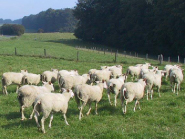Incidence d’un complément alimentaire à base de graines de lin ou de tourteau de colza fermier sur la composition des matières grasses du lait de petits ruminants maintenus à l’intérieur ou laissées au pâturage
Effects of linseed feed or rapeseed cake supplement on the fat composition of milk from housed or grazing small ruminants
-
-

Table 1 : Milk production, useful fraction and milk fatty acid pattern according to type of supplement (ewe trials) - Table 2 : Milk production, useful fraction and milk fatty acid pattern according to type of supplement (goat trial)

Incidence d’un complément alimentaire à base de graines de lin ou de tourteau de colza fermier sur la composition des matières grasses du lait de petits ruminants maintenus à l’intérieur ou laissées au pâturage
Previous
Next
Context
Milk fat has been the focus of renewed interest in the last few years, due to the presence of particular fatty acids, namely conjugated linoleic acids (CLA), which are thought to have favourable effects on human health. Depending on the animal feeding system, the milk may also contain appreciable quantities of linolenic acid (C18:3 cis). Research in this area is mainly directed at cow’s milk but, as far as we are aware, little information is available on ewe and goat’s milk.Objectives
Three trials were conducted on sheep to study the effect of adding linseed (native, flattened or extruded) to ewe feed on milk production and on the dietetic quality of milk fat produced in housing or pasture environment. A fourth trial was carried out on housed goats to study the supplementation effect of linseed (flattened or extruded) and rapeseed cake on the FA profil of milk.Results obtained
The first trial, with housed sheep, shows that adding 5% extruded linseed to the concentrate perceptibly improves the dietetic quality of ewe’s milk fat (Table 1). The addition of linseed in fact increases the levels of linolenic acid (+147%), CLA – C18:2 CONJ- (+98%), stearic acid -C18:0- (+54%), monounsaturated fatty acids -MUFA- (+32%) and polyunsaturated fatty acids -PUFA- (+86%), while at the same time reducing the saturated fatty acid -SFA- content (-11%) and the n-6/n-3 ratio (-39%). In both trials, extruded linseed supplementation had no significant effect on the quantity of milk produced or on the useful fractions (Tables 1 and 2), except on the protein content in Trial 1. In the second trial, linseed supplementation did not have a decidedly positive effect on the dietetic quality of the milk fat (Table 2), the only significant differences being a decrease in the total saturated fatty acids (SFA) and an increase in the monounsaturated fatty acids (MUFA). Lastly, the increase in the vaccenic fatty acid content (C18:1 11-trans) noted with the ‘linseed’ batch is not clearly associated with an increase in rumenic acid (C18:2 9-cis, 11-trans) (P=0.139). As regards alpha-linolenic acid (C18:3 n-3), levels in milk from grazing ewes are relatively moderate (Table 1), despite the sizeable amounts delivered by the grass and linseed. Milk conjugated linoleic acid (CLA) levels, on the other hand, are especially high in the spring trial, confirming the beneficial effect of grazing on endogenous production of these fatty acids (Chilliard et al., 2001). A comparison of this spring trial with the previous trial involving indoor winter feeding shows the effect of the basic ration upon the milk fatty acid pattern. A comparison of the fatty acid patterns of milk from the ‘control’ batches in the spring and winter trials reveals a positive general effect from grazing on grass upon the dietetic quality of the milk fat. Moreover, the system based on grazing favours CLA synthesis more than the other, while the C18:3 n-3 content is higher with the concentrate-based winter system, suggesting greater hydrogenation of food fats with grass than with indoor feeding. A longer food particle rumen retention time associated with increased cellulolytic activity could explain a more complete biohydrogenation process with grass. This is corroborated by the perceptible increase in the proportion of vaccenic acid (a biohydrogenation intermediary) with grazing. The third trial shows no modification on the composition of the milk fat content between flattening and the whole linseed (table 1). However, significant differences are observed in the FA profile when the linseed is extruded. Higher contents in rumenic acid, trans-vaccenic acid and polyunsatured fatty acids are also observed. Although a tendency of "a more dietetic" milk is shown in favour of extrusion, the composition in the milk fatty acids obtained with whole linseed is already very interessant. The native form of linseed can thus constitute a good choice for the dairy sheep producer who wants to start on the “Omega-3” market. The goat’s trial reveals any significant difference neither on the quantity of milk produced, nor on the contents of useful matters between diets (table 2). The FA profile presents a proportion of MUFA significantly more important with the rapeseed diet, which can be explained by the greatest richness of the oil of the rapeseed cake in MUFA (60% of FA). Higher PUFA and C18: 3 cis contents, and decreases of the n-6/n-3 are observed with the extruded linseed complementation. Rumenic acid content (C18: 2 c-9, t-11) is significantly higher with rapeseed cake and extruded linseed complementations. These results seem to show that the extruded linseed and rapeseed cake induce a more important hydrogenation of the linoleic acid in the rumen. As observed on ewe's milk, the linseed supplement allows a significant enrichment of milk in Omega-3 supported by the treatment of extrusion.Contribution
CRA-WPartners
Catholic University of Louvain MR-W, Department of Development and Extension CRAW off coordinator
BARTIAUX-THILL Nicole (Inspecteur général scientifique) Rue de Liroux, 8 B-5030 Gembloux Téléphone direct :62 67 71 Téléphone département :+ 32 (0) 81/61.27.39 - 61.27.40 Fax département :+ 32 (0) 81/61.58.68 E-mail :bartiaux@cra.wallonie.be Funding



